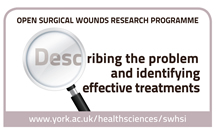Open surgical wounds – The epidemiology, management and impact of surgical wounds healing by secondary intention
There was little information about open surgical wounds healing from the base up. The publications resulting from this programme of work provide a better understanding of the nature, extent, costs, impact and outcomes of surgical wound healing by secondary intention, effective treatments, and the value and nature of further research.
Why did we do this research?
Surgical wounds healing by secondary intention are open wounds that are left to heal from the base up. At the start of this work, there was little information on these wounds, their management, impact on patients and which treatments offered best value for money. The overall aim of this research was therefore to describe, characterise and identify the nature and impact of surgical wounds healing by secondary intention and the current evidence for effective treatments.
What did we do?
The research programme involved four overlapping workstreams which included: a cross-sectional survey; inception cohort; cost-effectiveness and value of implementation analyses; qualitative interviews; and a pilot, feasibility randomised controlled trial.
The pilot, feasibility randomised controlled trial (SWHSI) compared negative-pressure wound therapy – a device applying a controlled vacuum to a wound via a dressing – with usual care (no negative-pressure wound therapy).
Who was involved?
Adults with previous experience of a surgical wound healing by secondary intention. Inclusion criteria varied between the individual workstreams: patients and practitioners took part in the qualitative interviews.
What did we find?
This programme of research found the following:
- Surgical wounds healing by secondary intention are very common and can take a long time to heal, negatively impacting quality of life.
- Several factors are associated with delayed wound healing (e.g. wound infections and wound size).
- Wound dressings are often used as the first treatment, but sometimes a vacuum device called negative-pressure wound therapy is used.
- Definitive evidence about the comparative effects of negative-pressure wound therapy and standard dressing may still be required in the form of a large randomised clinical trial; SWHSI, our small pilot study, has shown that such a study is possible.
- Further studies are required to assess other treatments for other surgical wounds healing by secondary intention and to improve patient well-being and care.
- Specialised analysis methods showed that negative-pressure wound therapy was less effective and did not offer value for money compared with standard wound dressings. It is possible that these findings are due to differences between the people receiving the different treatments, rather than the treatments themselves.
What happened next?
Following the outcome of the SWHSI feasibility study, a full RCT was funded by NIHR. For further details see the project page for SWHSI-2 A pragmatic multicentre randomised controlled trial to assess the clinical and cost effectiveness of negative pressure wound therapy versus usual care for surgical wounds healing by secondary intention.
Publications
- Chetter I, Arundel C, Bell K, Buckley H, Claxton K, Corbacho Martin B, et al. The epidemiology, management and impact of surgical wounds healing by secondary intention: a research programme including the SWHSI feasibility RCT. NIHR Journals Library. Programme Grants Appl Res 2020;8(7) https://doi.org/10.3310/pgfar08070
- Arundel C, Fairhurst C, Corbacho-Martin B, Buckley H, Clarke E, Cullum N, et al. Pilot feasibility randomized clinical trial of negative-pressure wound therapy versus usual care in patients with surgical wounds healing by secondary intention. BJS Open. 2018 Apr 23;2(3):99-111. https://doi.org/10.1002/bjs5.49. PMID: 29951633
- Buckley H, Dumville J, Hodgkinson M, Wearmouth D, Barlow G, van der Woude M, et al. Characterisation of baseline microbiological and host factors in an inception cohort of people with surgical wounds healing by secondary intention reveals circulating IL-6 levels as a potential predictive biomarker of healing. Wellcome Open Res. 2020 Nov 19;5:80. https://doi.org/10.12688/wellcomeopenres.15688.2.
- Chetter IC, Oswald AV, McGinnis E, Stubbs N, Arundel C, Buckley H, et al. Patients with surgical wounds healing by secondary intention: A prospective, cohort study. Int J Nurs Stud. 2019 Jan;89:62-71. https://doi.org/10.1016/j.ijnurstu.2018.09.011. Epub 2018 Sep 18.
- McCaughan D, Sheard L, Cullum N, Dumville J, Chetter I. Patients' perceptions and experiences of living with a surgical wound healing by secondary intention: A qualitative study. Int J Nurs Stud. 2018 Jan;77:29-38. https://doi.org/10.1016/j.ijnurstu.2017.09.015. Epub 2017 Sep 28.

Team
- Catherine Arundel
- Kerry Bell
- Hannah Buckley
- Belen Corbacho Martin
- Caroline Fairhurst
- Dorothy McCaughan
- Laura Sheard
- David Torgerson
Department of Health Sciences, University of York, York, UK
- Ian Chetter
- Eileen Henderson
- Judith Long
- Angela Oswald
Hull University Teaching Hospitals NHS Trust, Hull, UK
- Karl Claxton
- Marta Soares
- Pedro Saramago Goncalves
Centre for Health Economics, University of York, York, UK
- Nicky Cullum
- Jo Dumville
Division of Nursing, Midwifery and Social Work, School of Health Sciences, University of Manchester, Manchester, UK
Karen Lamb
- Nikki Stubbs
Leeds Community Healthcare NHS Trust, Leeds, UK
- Elizabeth McGinnis
Leeds Teaching Hospitals NHS Trust, Leeds, UK
- Nicky Welton
School of Social and Community Medicine, University of Bristol, Bristol, UK
Funding
The research was funded by the NIHR Programme Grants for Applied Research programme (Award ID: RP-PG-0609-10171) and a grant of £2,103,324.00 awarded. The project was started in June 2011 and completed in January 2017.
Study Registration
Registration number: ISRCTN12761776 (http://www.iscrtn.com)
